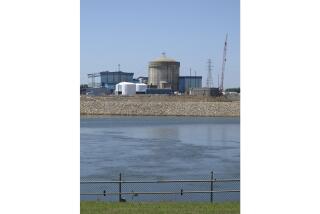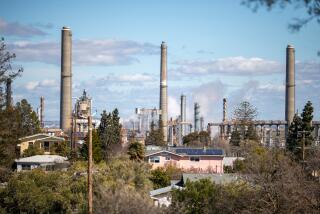Carbide Denies W. Virginia Plant Is a Threat, Downplays Report Warning of Leak
- Share via
WASHINGTON — Union Carbide Corp. officials, stung twice this week by disclosures of chemical spills and safety problems at the Institute, W. Va., plant that makes deadly methyl isocyanate, strongly denied Friday that the site poses a hazard to residents living nearby.
In twin news conferences in Institute and at Union Carbide’s Danbury, Conn., headquarters, company officials played down the seriousness of an internal safety assessment that warned last September of “a real potential” for a catastrophic gas leak at the Institute plant. The document was made public Thursday by Rep. Henry A. Waxman (D-Los Angeles).
The confidential assessment was written three months before Union Carbide’s other methyl isocyanate plant in Bhopal, India, sprang a disastrous leak Dec. 3, killing more than 2,000 persons and injuring tens of thousands more.
While the potential for a similar leak at the Institute plant “was in no way imminent, it received immediate attention” from plant officials after the assessment was written, Jackson B. Browning, Union Carbide’s health, safety and environmental director, said in Danbury.
Browning said a “simple change in procedures” eliminated the risk that water and other chemicals might seep into tanks of methyl isocyanate at the Institute plant and trigger a runaway chemical reaction that could have caused heated gas to begin spewing from the tanks.
In a prepared statement, he also said that the company had “no reason to share our Institute . . . report” with managers of the Bhopal plant because the major flaw cited in the assessment--a cooling system that could leak water into chemical tanks--was not used in Bhopal.
Union Carbide officials have depicted the safety assessment as part of a “devil’s advocate” process practiced by safety officials when they tour the company’s plants. Rep. Bob Wise (D-W.Va.) said that he was told Thursday by Union Carbide chairman Warren Anderson that the safety report presented a “worst-case scenario” and did not imply that an accident was imminent.
Browning also denied other allegations, contained in an Environmental Protection Agency review of the Institute plant released Wednesday, that Union Carbide might have violated federal law by failing to report spills of liquid methyl isocyanate.
EPA officials found evidence of 28 spills at the plant between 1980 and 1984, and said Wednesday that one of the spills involved 840 pounds of the chemical. Any leak of more than one pound not reported to the EPA is a violation of federal law that could draw a $10,000 fine and a jail term of up to one year.
The EPA’s 840-pound estimate was based on an “erroneous calculation,” Browning said, involving a mistaken identification of a methyl isocyanate pipe that had ruptured. He declined to say whether the EPA or Union Carbide was responsible for the miscalculation.
None of the 27 other spills were serious enough to merit reporting to EPA, Browning said, and little vaporized methyl isocyanate escaped from the plant.
More to Read
Inside the business of entertainment
The Wide Shot brings you news, analysis and insights on everything from streaming wars to production — and what it all means for the future.
You may occasionally receive promotional content from the Los Angeles Times.









